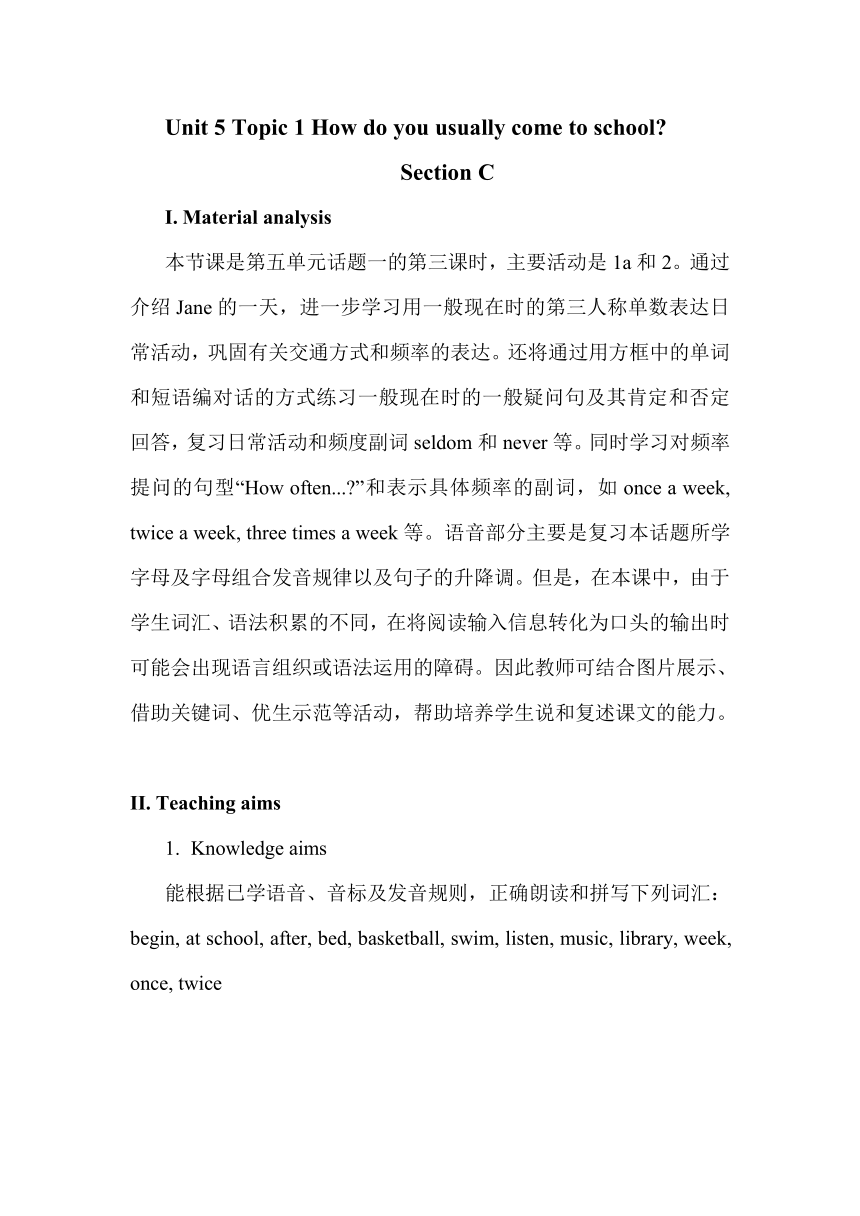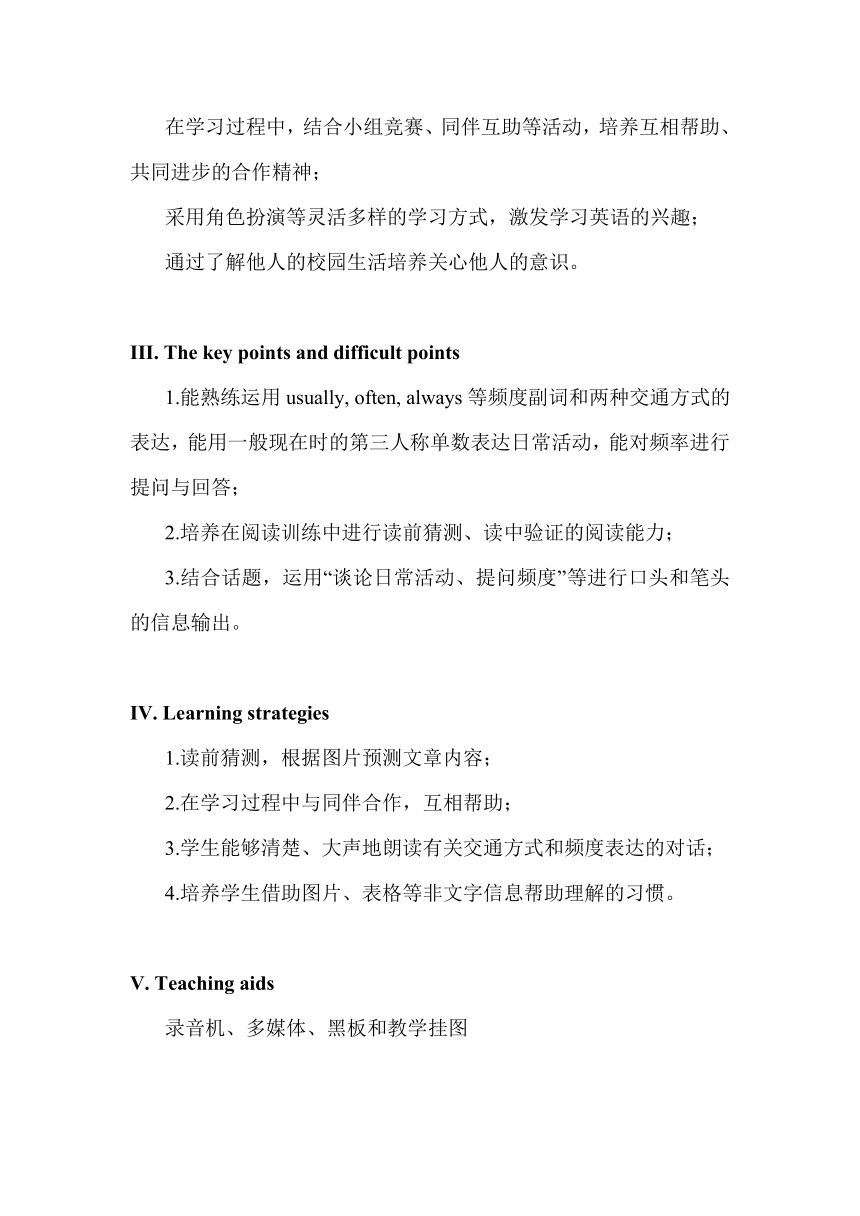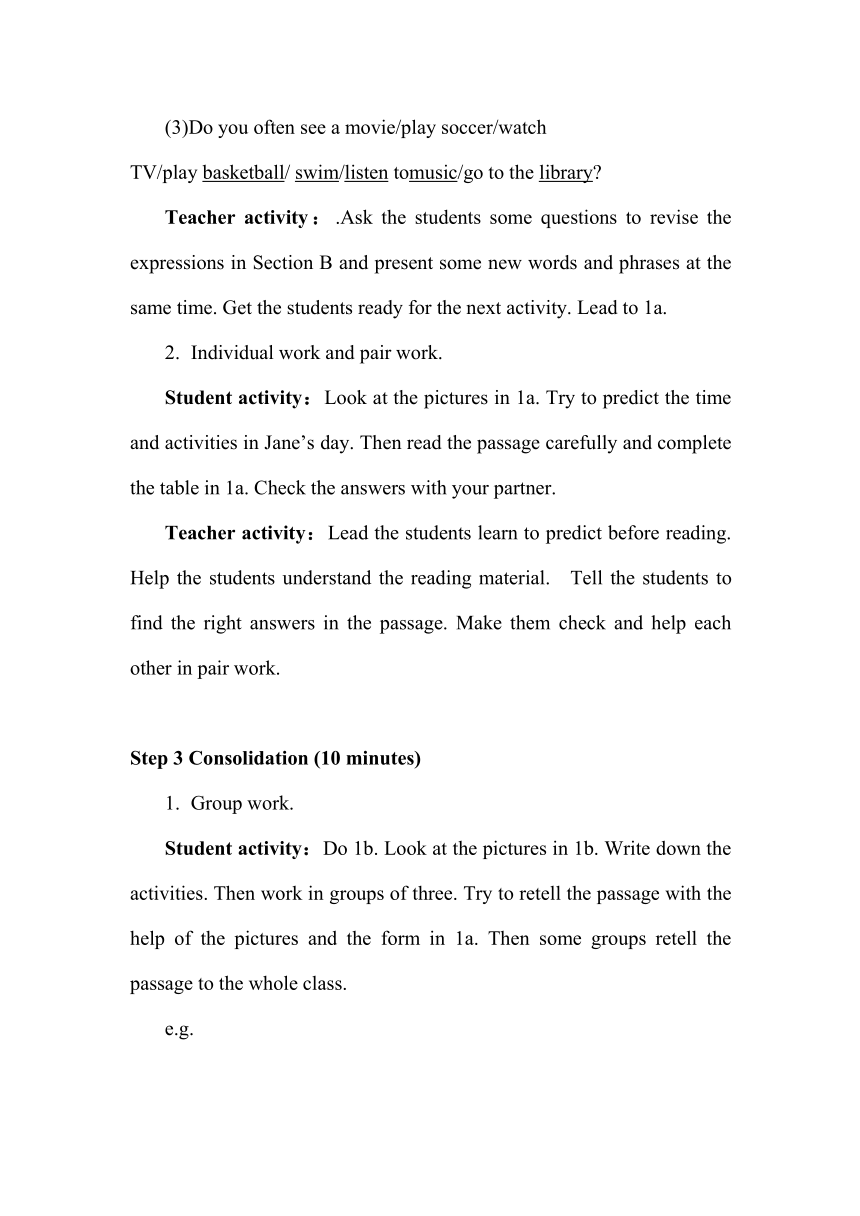Unit 5 Topic 1 I usually come to school by subway Section C 教案
文档属性
| 名称 | Unit 5 Topic 1 I usually come to school by subway Section C 教案 |  | |
| 格式 | zip | ||
| 文件大小 | 123.0KB | ||
| 资源类型 | 教案 | ||
| 版本资源 | 科普版 | ||
| 科目 | 英语 | ||
| 更新时间 | 2017-05-10 21:11:03 | ||
图片预览





文档简介
Unit
5
Topic
1
How
do
you
usually
come
to
school
Section
C
I.
Material
analysis
本节课是第五单元话题一的第三课时,主要活动是1a和2。通过介绍Jane的一天,进一步学习用一般现在时的第三人称单数表达日常活动,巩固有关交通方式和频率的表达。还将通过用方框中的单词和短语编对话的方式练习一般现在时的一般疑问句及其肯定和否定回答,复习日常活动和频度副词seldom和never等。同时学习对频率提问的句型“How
often... ”和表示具体频率的副词,如once
a
week,
twice
a
week,
three
times
a
week等。语音部分主要是复习本话题所学字母及字母组合发音规律以及句子的升降调。但是,在本课中,由于学生词汇、语法积累的不同,在将阅读输入信息转化为口头的输出时可能会出现语言组织或语法运用的障碍。因此教师可结合图片展示、借助关键词、优生示范等活动,帮助培养学生说和复述课文的能力。
II.
Teaching
aims
Knowledge
aims
能根据已学语音、音标及发音规则,正确朗读和拼写下列词汇:begin,
at
school,
after,
bed,
basketball,
swim,
listen,
music,
library,
week,
once,
twice
在Section
A和Section
B的语法基础上,能熟练运用usually,
often,
always等频度副词和两种交通方式的表达,能用一般现在时第三人称单数表达日常活动,能对频率进行提问与回答;
在Section
A已学的语音基础上,能结合图片和音标拼写单词,并能尝试结合语音发音规律拼读新单词,并了解句子的重音和升降调;
能结合话题,运用“谈论日常生活、询问和回答某项活动的频度”等交际功能的用法,进行口头和笔头的信息输出,如:
(1)I
usually
get
up
at
...
in
the
morning.
(2)At
...
o’clock
I
have
breakfast...
(3)—How
often
do
you
come
to
the
library
—Three
times
a
week.
Skill
aims
能听懂有关表达日常生活的叙述;
能听懂简单的课堂用语,并作出反应;
能根据图文就交通方式和日常活动的频度等进行交流;
能在阅读训练中进行读前猜测、读中验证的活动;
能根据图文理解相关话题,抓住大意和具体信息并根据要求进行学习活动;
能准确写出黑体单词和词组;
能写出表达交通方式和频度的简单句子。
Emotional
aims
在学习过程中,结合小组竞赛、同伴互助等活动,培养互相帮助、共同进步的合作精神;
采用角色扮演等灵活多样的学习方式,激发学习英语的兴趣;
通过了解他人的校园生活培养关心他人的意识。
III.
The
key
points
and
difficult
points
1.能熟练运用usually,
often,
always等频度副词和两种交通方式的表达,能用一般现在时的第三人称单数表达日常活动,能对频率进行提问与回答;
2.培养在阅读训练中进行读前猜测、读中验证的阅读能力;
3.结合话题,运用“谈论日常活动、提问频度”等进行口头和笔头的信息输出。
IV.
Learning
strategies
1.读前猜测,根据图片预测文章内容;
2.在学习过程中与同伴合作,互相帮助;
3.学生能够清楚、大声地朗读有关交通方式和频度表达的对话;
4.培养学生借助图片、表格等非文字信息帮助理解的习惯。
V.
Teaching
aids
录音机、多媒体、黑板和教学挂图
VI.
Teaching
procedures
Step
1 Introduction
(5
minutes)
The
whole
class
work.
Student
activity:Focus
their
attention
on
the
teacher.
Teacher
activity:Get
students
ready
for
learning.
Individual
work.
Student
activity:Do
duty
report.
Talk
about
your
survey
result
of
your
group
members’
activities.
e.g.
In
my
survey,
A
usually
gets
up
at
about
6
o’clock.
He
usually
comes
to
school
on
foot,
but
sometimes
by
bus.
He
seldom
watches
TV
on
weekdays.
But
he
often
plays
soccer
on
Sundays.
Sometimes
he
sees
movies
with
his
parents
on
weekends.
Teacher
activity:Help
the
students
to
revise
adverbs
of
frequency
and
two
ways
of
expressing
means
of
transportation.
Step
2
Presentation
(10
minutes)
Individual
work.
Student
activity:Do
1a.
Answer
the
teacher’s
questions.
Learn
some
new
words
while
answering:
(1)What
time
do
you
usually
get
up/have
breakfast
on
weekdays
(2)How
do
you
usually
go
to
school
(3)Do
you
often
see
a
movie/play
soccer/watch
TV/play basketball/ swim/listen tomusic/go
to
the library
Teacher
activity:.Ask
the
students
some
questions
to
revise
the
expressions
in
Section
B
and
present
some
new
words
and
phrases
at
the
same
time.
Get
the
students
ready
for
the
next
activity.
Lead
to
1a.
Individual
work
and
pair
work.
Student
activity:Look
at
the
pictures
in
1a.
Try
to
predict
the
time
and
activities
in
Jane’s
day.
Then
read
the
passage
carefully
and
complete
the
table
in
1a.
Check
the
answers
with
your
partner.
Teacher
activity:Lead
the
students
learn
to
predict
before
reading.
Help
the
students
understand
the
reading
material.
Tell
the
students
to
find
the
right
answers
in
the
passage.
Make
them
check
and
help
each
other
in
pair
work.
Step
3
Consolidation
(10
minutes)
Group
work.
Student
activity:Do
1b.
Look
at
the
pictures
in
1b.
Write
down
the
activities.
Then
work
in
groups
of
three.
Try
to
retell
the
passage
with
the
help
of
the
pictures
and
the
form
in
1a.
Then
some
groups
retell
the
passage
to
the
whole
class.
e.g.
Jane
usually
gets
up
at
6:20
a.m.
She
has
breakfast
at
7:00.
Then
she
goes
to
school
at
7:30
a.m.
Classes
begin
at
8:00.
Teacher
activity:Make
the
students
learn
to
retell
the
passage
with
the
help
of
the
pictures
and
forms.
Step
4
Practice
(10
minutes)
The
whole
class
work.
Student
activity:Do
2.
Look
at
the
pictures
of
2.
Talk
about
what
the
people
usually
do.
Consolidate
the
new
words.
Teacher
activity:Show
the
pictures
of
2.
Get
the
students
ready
for
the
next
activity.
Pair
work.
Student
activity:Ask
and
answer
questions
with
the
information
in
2
after
the
example
in
pairs.
Then
some
pairs
act
out
the
dialogs.
e.g.
A:
What
does
Wen
Wei
usually
do
after
school
B:
He
usually
goes swimming,
but
he doesn’t
go fishing.
Teacher
activity:Help
the
students
to
express
correctly.
The
whole
class
work
and
pair
work.
Student
activity:Do
3.
Answer
the
teacher’s
questions
after
the
teacher’s
presentation.
T:
I
like
watching
TV.
I
watch
TV
on
Friday,
Saturday
and
Sunday.
How
often
do
I
watch
TV
S:
You
watch
TV
three
times
a
week.
...
Then
work
in
pairs.
Make
up
new
conversations
with
the
words
and
phrases
in
the
box
after
the
example.
Some
pairs
act
out
your
new
conversations
to
the
whole
class.
e.g.
A:
Do
you
often
listen
to
music
B:
Yes,
I
do.
A:
How
often
do
you
listen
to
music
B:
Three
times
a
week.
...
Teacher
activity:Help
the
students
learn
to
ask
and
answer
questions
with
“How
often... ”
and
“once,
twice,
three
times
a
week”.
Then
make
them
practice
these
expressions
in
new
conversations.
Individual
work
and
pair
work.
Student
activity:Do
4a.
Look
at
the
pictures
in
4a.
Try
to
read
the
sounds.
Then
spell
the
words
with
the
rules
you
have
learned
in
Section
A.
Check
your
answers
with
your
partner.
Teacher
activity:Make
the
students
use
the
rules
they
have
learned
to
read
and
spell
the
words
by
themselves.
Group
work.
Student
activity:Have
a
group
competition.
The
teacher
shows
the
flashcards
of
these
sounds.
The
students
try
to
spell
the
words
correctly
as
quickly
as
you
can.
The
group
which
can
spell
the
most
correct
words
in
the
shortest
time
will
be
the
winner
in
this
group
competition.
Teacher
activity:Organize
a
group
competition
to
help
the
students
spell
the
words.
The
whole
class
work
and
individual
work.
Student
activity:Do
4b.
Look
at
the
pictures
in
4b.
Guess
what
kind
of
words
may
appear.
Then
try
to
read
the
sentences
in
4b
by
yourselves.
After
that,
listen
to
the
tape,
check
and
repeat.
Pay
attention
to
the
rising
tone
and
the
falling
tone.
The
whole
class
practice
together.
Teacher
activity:Play
the
tape
recorder.
Help
the
students
learn
to
read
correctly.
Correct
their
sentence
tone.
Step
5
Production
(10
minutes)
Individual
work
and
group
work.
Student
activity:Do
1c.
Draw
your
daily
activities
form
similar
to
1a.
Then
talk
with
your
group
members
about
your
day
with
the
help
of
the
form.
Some
students
report
your
passages
to
the
class.
e.g.
I
usually
get
up
at
6:30
a.m.
At
7:00,
I
have
breakfast.
......is
my
partner.
He/She
usually
gets
up
at
6:20
in
the
morning...
Teacher
activity:Help
the
students
to
express
their
daily
activities
correctly.
Assign
the
homework:
1.
Read
1a
aloud
and
fluently;
2.
Review
the
words
and
expressions
in
this
section;
3.
Preview
Section
D;
4.
Make
a
survey.
Ask
your
classmates
some
questions
and
then
fill
in
the
following
form.
Report
it
to
the
whole
class
the
next
day.
activity
frequency
Watch
TV
Listen
to
music
Play
soccer
Read
books
in
the
library
Cook
Go
to
the
zoo
Meet
friends
VII.
Blackboard
design
Topic1
How
do
you
usually
come
to
school Section
C—What
does
Han
Qing
usually
do
after
school
begin
at
school
—He
usually
plays
soccer,
but
he
doesn’t
play
basketball.
after
bed—How
often
do
you
come
to
the
library
basketball
swim
—Three
times
a
week.
/Once
a
week./
Twice
a
week.
listen
music library
week
once
twice
5
Topic
1
How
do
you
usually
come
to
school
Section
C
I.
Material
analysis
本节课是第五单元话题一的第三课时,主要活动是1a和2。通过介绍Jane的一天,进一步学习用一般现在时的第三人称单数表达日常活动,巩固有关交通方式和频率的表达。还将通过用方框中的单词和短语编对话的方式练习一般现在时的一般疑问句及其肯定和否定回答,复习日常活动和频度副词seldom和never等。同时学习对频率提问的句型“How
often... ”和表示具体频率的副词,如once
a
week,
twice
a
week,
three
times
a
week等。语音部分主要是复习本话题所学字母及字母组合发音规律以及句子的升降调。但是,在本课中,由于学生词汇、语法积累的不同,在将阅读输入信息转化为口头的输出时可能会出现语言组织或语法运用的障碍。因此教师可结合图片展示、借助关键词、优生示范等活动,帮助培养学生说和复述课文的能力。
II.
Teaching
aims
Knowledge
aims
能根据已学语音、音标及发音规则,正确朗读和拼写下列词汇:begin,
at
school,
after,
bed,
basketball,
swim,
listen,
music,
library,
week,
once,
twice
在Section
A和Section
B的语法基础上,能熟练运用usually,
often,
always等频度副词和两种交通方式的表达,能用一般现在时第三人称单数表达日常活动,能对频率进行提问与回答;
在Section
A已学的语音基础上,能结合图片和音标拼写单词,并能尝试结合语音发音规律拼读新单词,并了解句子的重音和升降调;
能结合话题,运用“谈论日常生活、询问和回答某项活动的频度”等交际功能的用法,进行口头和笔头的信息输出,如:
(1)I
usually
get
up
at
...
in
the
morning.
(2)At
...
o’clock
I
have
breakfast...
(3)—How
often
do
you
come
to
the
library
—Three
times
a
week.
Skill
aims
能听懂有关表达日常生活的叙述;
能听懂简单的课堂用语,并作出反应;
能根据图文就交通方式和日常活动的频度等进行交流;
能在阅读训练中进行读前猜测、读中验证的活动;
能根据图文理解相关话题,抓住大意和具体信息并根据要求进行学习活动;
能准确写出黑体单词和词组;
能写出表达交通方式和频度的简单句子。
Emotional
aims
在学习过程中,结合小组竞赛、同伴互助等活动,培养互相帮助、共同进步的合作精神;
采用角色扮演等灵活多样的学习方式,激发学习英语的兴趣;
通过了解他人的校园生活培养关心他人的意识。
III.
The
key
points
and
difficult
points
1.能熟练运用usually,
often,
always等频度副词和两种交通方式的表达,能用一般现在时的第三人称单数表达日常活动,能对频率进行提问与回答;
2.培养在阅读训练中进行读前猜测、读中验证的阅读能力;
3.结合话题,运用“谈论日常活动、提问频度”等进行口头和笔头的信息输出。
IV.
Learning
strategies
1.读前猜测,根据图片预测文章内容;
2.在学习过程中与同伴合作,互相帮助;
3.学生能够清楚、大声地朗读有关交通方式和频度表达的对话;
4.培养学生借助图片、表格等非文字信息帮助理解的习惯。
V.
Teaching
aids
录音机、多媒体、黑板和教学挂图
VI.
Teaching
procedures
Step
1 Introduction
(5
minutes)
The
whole
class
work.
Student
activity:Focus
their
attention
on
the
teacher.
Teacher
activity:Get
students
ready
for
learning.
Individual
work.
Student
activity:Do
duty
report.
Talk
about
your
survey
result
of
your
group
members’
activities.
e.g.
In
my
survey,
A
usually
gets
up
at
about
6
o’clock.
He
usually
comes
to
school
on
foot,
but
sometimes
by
bus.
He
seldom
watches
TV
on
weekdays.
But
he
often
plays
soccer
on
Sundays.
Sometimes
he
sees
movies
with
his
parents
on
weekends.
Teacher
activity:Help
the
students
to
revise
adverbs
of
frequency
and
two
ways
of
expressing
means
of
transportation.
Step
2
Presentation
(10
minutes)
Individual
work.
Student
activity:Do
1a.
Answer
the
teacher’s
questions.
Learn
some
new
words
while
answering:
(1)What
time
do
you
usually
get
up/have
breakfast
on
weekdays
(2)How
do
you
usually
go
to
school
(3)Do
you
often
see
a
movie/play
soccer/watch
TV/play basketball/ swim/listen tomusic/go
to
the library
Teacher
activity:.Ask
the
students
some
questions
to
revise
the
expressions
in
Section
B
and
present
some
new
words
and
phrases
at
the
same
time.
Get
the
students
ready
for
the
next
activity.
Lead
to
1a.
Individual
work
and
pair
work.
Student
activity:Look
at
the
pictures
in
1a.
Try
to
predict
the
time
and
activities
in
Jane’s
day.
Then
read
the
passage
carefully
and
complete
the
table
in
1a.
Check
the
answers
with
your
partner.
Teacher
activity:Lead
the
students
learn
to
predict
before
reading.
Help
the
students
understand
the
reading
material.
Tell
the
students
to
find
the
right
answers
in
the
passage.
Make
them
check
and
help
each
other
in
pair
work.
Step
3
Consolidation
(10
minutes)
Group
work.
Student
activity:Do
1b.
Look
at
the
pictures
in
1b.
Write
down
the
activities.
Then
work
in
groups
of
three.
Try
to
retell
the
passage
with
the
help
of
the
pictures
and
the
form
in
1a.
Then
some
groups
retell
the
passage
to
the
whole
class.
e.g.
Jane
usually
gets
up
at
6:20
a.m.
She
has
breakfast
at
7:00.
Then
she
goes
to
school
at
7:30
a.m.
Classes
begin
at
8:00.
Teacher
activity:Make
the
students
learn
to
retell
the
passage
with
the
help
of
the
pictures
and
forms.
Step
4
Practice
(10
minutes)
The
whole
class
work.
Student
activity:Do
2.
Look
at
the
pictures
of
2.
Talk
about
what
the
people
usually
do.
Consolidate
the
new
words.
Teacher
activity:Show
the
pictures
of
2.
Get
the
students
ready
for
the
next
activity.
Pair
work.
Student
activity:Ask
and
answer
questions
with
the
information
in
2
after
the
example
in
pairs.
Then
some
pairs
act
out
the
dialogs.
e.g.
A:
What
does
Wen
Wei
usually
do
after
school
B:
He
usually
goes swimming,
but
he doesn’t
go fishing.
Teacher
activity:Help
the
students
to
express
correctly.
The
whole
class
work
and
pair
work.
Student
activity:Do
3.
Answer
the
teacher’s
questions
after
the
teacher’s
presentation.
T:
I
like
watching
TV.
I
watch
TV
on
Friday,
Saturday
and
Sunday.
How
often
do
I
watch
TV
S:
You
watch
TV
three
times
a
week.
...
Then
work
in
pairs.
Make
up
new
conversations
with
the
words
and
phrases
in
the
box
after
the
example.
Some
pairs
act
out
your
new
conversations
to
the
whole
class.
e.g.
A:
Do
you
often
listen
to
music
B:
Yes,
I
do.
A:
How
often
do
you
listen
to
music
B:
Three
times
a
week.
...
Teacher
activity:Help
the
students
learn
to
ask
and
answer
questions
with
“How
often... ”
and
“once,
twice,
three
times
a
week”.
Then
make
them
practice
these
expressions
in
new
conversations.
Individual
work
and
pair
work.
Student
activity:Do
4a.
Look
at
the
pictures
in
4a.
Try
to
read
the
sounds.
Then
spell
the
words
with
the
rules
you
have
learned
in
Section
A.
Check
your
answers
with
your
partner.
Teacher
activity:Make
the
students
use
the
rules
they
have
learned
to
read
and
spell
the
words
by
themselves.
Group
work.
Student
activity:Have
a
group
competition.
The
teacher
shows
the
flashcards
of
these
sounds.
The
students
try
to
spell
the
words
correctly
as
quickly
as
you
can.
The
group
which
can
spell
the
most
correct
words
in
the
shortest
time
will
be
the
winner
in
this
group
competition.
Teacher
activity:Organize
a
group
competition
to
help
the
students
spell
the
words.
The
whole
class
work
and
individual
work.
Student
activity:Do
4b.
Look
at
the
pictures
in
4b.
Guess
what
kind
of
words
may
appear.
Then
try
to
read
the
sentences
in
4b
by
yourselves.
After
that,
listen
to
the
tape,
check
and
repeat.
Pay
attention
to
the
rising
tone
and
the
falling
tone.
The
whole
class
practice
together.
Teacher
activity:Play
the
tape
recorder.
Help
the
students
learn
to
read
correctly.
Correct
their
sentence
tone.
Step
5
Production
(10
minutes)
Individual
work
and
group
work.
Student
activity:Do
1c.
Draw
your
daily
activities
form
similar
to
1a.
Then
talk
with
your
group
members
about
your
day
with
the
help
of
the
form.
Some
students
report
your
passages
to
the
class.
e.g.
I
usually
get
up
at
6:30
a.m.
At
7:00,
I
have
breakfast.
......is
my
partner.
He/She
usually
gets
up
at
6:20
in
the
morning...
Teacher
activity:Help
the
students
to
express
their
daily
activities
correctly.
Assign
the
homework:
1.
Read
1a
aloud
and
fluently;
2.
Review
the
words
and
expressions
in
this
section;
3.
Preview
Section
D;
4.
Make
a
survey.
Ask
your
classmates
some
questions
and
then
fill
in
the
following
form.
Report
it
to
the
whole
class
the
next
day.
activity
frequency
Watch
TV
Listen
to
music
Play
soccer
Read
books
in
the
library
Cook
Go
to
the
zoo
Meet
friends
VII.
Blackboard
design
Topic1
How
do
you
usually
come
to
school Section
C—What
does
Han
Qing
usually
do
after
school
begin
at
school
—He
usually
plays
soccer,
but
he
doesn’t
play
basketball.
after
bed—How
often
do
you
come
to
the
library
basketball
swim
—Three
times
a
week.
/Once
a
week./
Twice
a
week.
listen
music library
week
once
twice
同课章节目录
- Unit 5 Our school life
- Topic 1 I usually come to school by subway.
- Topic 2 A few students are running around the play
- Topic 3 My school life is very interesting.
- Unit 6 Our local area
- Topic 1 Is there a computer in your study?
- Topic 2 My home is in an apartment building.
- Topic 3 Which is the way to the hospital?
- Review of Units 5-6
- Unit 7 The Birthday
- Topic 1 When is your birthday?
- Topic 2 Can you sing an English song?
- Topic 3 Everyone had a good time.
- Unit 8 The seasons and the Weathe
- Topic 1 What's the weather like in summer?
- Topic 2 The summer holidays are coming.
- Topic 3 Let’s celebrate!
- Review of Units 7-8
- 旧版资料
- Unit 5 Our School Life
- Unit 6 Our Local Area
- Unit 7 The Birthday
- Unit 8 The seasons and the Weathe
- Unit 7 Celebrating the Birthday(老版本)
